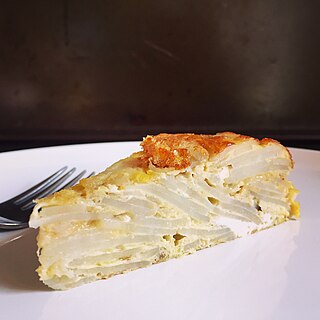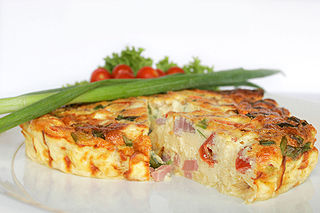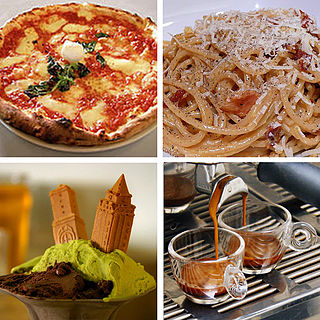
Gnocchi are a varied family of dumpling in Italian cuisine. They are made of small lumps of dough, such as those composed of a simple combination of wheat flour, potato, egg, and salt. Variations of the dish supplement the simple recipe with flavour additives, such as semolina flour, cheese, breadcrumbs, cornmeal or similar ingredients, and possibly including herbs, vegetables, and other ingredients. Base ingredients may be substituted with alternatives such as sweet potatoes for potatoes or rice flour for wheat flour. Such variations are often considered to be non-traditional.

Lasagna is a type of pasta, possibly one of the oldest types, made of very wide, flat sheets. Either term can refer to an Italian dish made of stacked layers of lasagna alternating with fillings such as ragù, béchamel sauce, vegetables, cheeses, and seasonings and spices. The dish may be topped with grated cheese, which becomes melted during baking. Typically cooked pasta is assembled with the other ingredients and then baked in an oven. The resulting baked pasta is cut into single-serving square or rectangular portions.

An omelette is a dish made from beaten eggs fried and folded around fillings such as chives, vegetables, mushrooms, meat, cheese, or onions.

Spanish omelette or Spanish tortilla is a traditional dish from Spain. It is celebrated as one of the most popular dishes of the Spanish cuisine. It is an omelette made with eggs and potatoes, usually including onion. It is often served at room temperature as a tapa.

Polish cuisine is a style of food preparation originating in and widely popular in Poland. Due to Poland's history, Polish cuisine has evolved over the centuries to be very eclectic, and shares many similarities with other national cuisines. Polish cooking in other cultures is often referred to as à la polonaise.

Pizzoccheri is a type of short tagliatelle, a flat ribbon pasta, made with a blend of buckwheat flour and wheat flour. It is believed to have originated in Valtellina, a valley in the northern Italian region of Lombardy. They are also popular in Val Poschiavo, a side valley of Valtellina which belongs to the Swiss canton of Grisons.

Frittata is an egg-based Italian dish similar to an omelette or crustless quiche or scrambled eggs, enriched with additional ingredients such as meats, cheeses, or vegetables. The word frittata is Italian and roughly translates to 'fried'.

Salade niçoise is a salad that originated in the French city of Nice. It is traditionally made of tomatoes, hard-boiled eggs, Niçoise olives and anchovies or tuna, dressed with olive oil, or in some historical versions, a vinaigrette. It has been popular worldwide since the early 20th century, and has been prepared and discussed by many chefs. Delia Smith called it "one of the best combinations of salad ingredients ever invented" and Gordon Ramsay said that "it must be the finest summer salad of all".

Italian cuisine is a Mediterranean cuisine consisting of the ingredients, recipes and cooking techniques developed in Italy since Roman times and later spread around the world together with waves of Italian diaspora. Some of these foods were imported from other cultures. Significant changes occurred with the colonization of the Americas and the introduction of potatoes, tomatoes, capsicums, maize and sugar beet—the latter introduced in quantity in the 18th century. It is one of the best-known and most appreciated gastronomies worldwide.

Shakshouka is a Maghrebi dish of eggs poached in a sauce of tomatoes, olive oil, peppers, onion, and garlic, commonly spiced with cumin, paprika and cayenne pepper. Shakshouka is a popular dish throughout North Africa and the Middle East.

Tunisian cuisine, the cuisine of Tunisia, consists of the cooking traditions, ingredients, recipes and techniques developed in Tunisia since antiquity. It is mainly a blend of Mediterranean and native Punics-Berber cuisine. Historically, Tunisian cuisine witnessed influence and exchanges with many cultures and nations like Italians, Andalusians, French and Arabs.

Neapolitan cuisine has ancient historical roots that date back to the Greco-Roman period, which was enriched over the centuries by the influence of the different cultures that controlled Naples and its kingdoms, such as that of Aragon and France.

Cappon magro is an elaborate Genoese salad of seafood and vegetables over hardtack arranged into a decorative pyramid and dressed with a rich sauce.

Kuku or kookoo is an egg-based and often vegetarian Iranian dish made of whipped eggs folded in various ingredients. It is similar to the Italian frittata, the French quiche, or an open-faced omelette, but it typically has less egg than a frittata, and it cooks for a shorter amount of time, over a low heat, before turned over or grilled briefly to set the top layer. It is served either hot or cold as a starter, side dish or a main course, and is accompanied with bread and either yogurt or salad.

Olivier salad is a traditional salad dish of Russian cuisine. Its creation is generally attributed to Lucien Olivier.

U' pastizz 'rtunnar, commonly known as pastizz, is a baked turnover with a savoury filling, typical of the Basilicata region of Italy.

Tumact me tulez is a pasta dish from southern Italy, specifically Basilicata, of Arbëreshe origin.

The cuisine of Basilicata, or Lucanian cuisine, is the cuisine of the Basilicata region of Italy. It is mainly based on the use of pork and sheep meat, legumes, cereals and vegetables, with the addition of aromas such as hot peppers, powdered raw peppers and horseradish. The local gastronomy is, for historical-cultural reasons, typically peasant, based on simple recipes and on the culture of reuse, in particular of meat and bread.

















